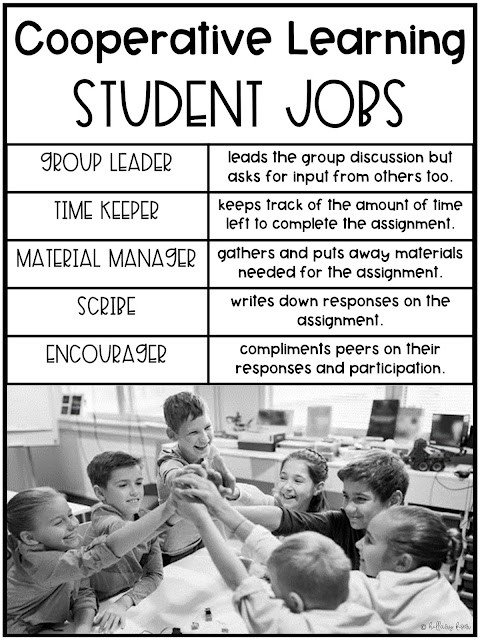If you are just joining in on my Sunday Strategy Share, make sure you check out last week’s Visual Content Strategy Share!
This week we will be chatting all about cooperative learning in the classroom. Why is cooperative learning important? How does it benefit the kids? And what you really want to know...how can you (as the teacher) include cooperative learning in your classroom without breaking the bank?
1. Rules and Procedures
Create strong rules and procedures in your classroom for cooperative learning. If you do this from the beginning, it will help your groups and activities run smoothly! Kids need to know what you expect and how they are to treat each other. I have found the best way to learn these procedures is through exposure to the process. Add in cooperative learning to a lesson and discuss the rules and procedures during the process. Just discussing rules beforehand doesn’t make much impact. Immerse them in the cooperative learning atmosphere and discuss do’s and don’ts.
We use this anchor chart and it really helps remind the students of what is expected.
2. Choosing Groups
When choosing groups for your students, be sure to make the groups meaningful. Many times, we just allow the students to choose their own groups. The problem with this idea is that students will choose their best friends almost every time. Put systems in place that allow for high and low students to be mixed together when grouping. There are many different ways this can be done. My personal favorite (and the least obvious) is explained below.
Draw Sticks: Have students names (or numbers) written on sticks and placed in two separate jars. Maybe name one jar A and one jar B--or you can be more creative. Secretly, have the jars divided into low/middle and middle/high. Place middle of the road children in each jar. I have done this for years and the students never get suspicious. Draw out sticks from each jar (if you are doing a group of four--two sticks from each jar.) Now, your groups may not always be perfect--but they will work well.
When you choose your groups and make them meaningful--the students are more engaged (not always with their friends.) The students also learn to work with other people in the classroom and you will see great strengths from your children that struggle.
3. Work Load
When the students are in their groups, be sure to divide the workload. You do not want one student doing all of the work. And believe me, you will have a bossy-bessy that will try to do all of the work.
I use a job chart in each group. As soon as the students get into their groups--they choose jobs or jobs are chosen for them (if bossy-bessy is still taking control.) I do try to give them some freedom here. Just check in on them and make sure the same person isn't doing the same job each time though. Mixing up the groups helps with this process though!
4. Guide Discussions
The discussions during any type of cooperative learning can get really off track if you are not monitoring the students. Before you start rolling your eyes though, I don't mean you are just sitting at your desk eating that eighth piece of chocolate for the day. I know when cooperative learning is going on, you are up and moving around. However, you will need to actually guide their discussions more than humanly possible with 4 or 5 groups going at a time. I have caught myself running from one group to another and feeling pretty overwhelmed.
I decided it was best to come up with a process of discussion each group would navigate through during cooperative learning. I really got the idea from how I run my book clubs. They can be very similar in making me feel overwhelmed. Organization is key. Also, don't be afraid to give your students some responsibility.
5. Tools for Support
Lastly, you might be thinking...yes--but what do I do with the students while they are cooperatively learning? How will I do all of this with limited materials?
My favorite thing about students learning together is the creativity that is allowed. Below, I have listed some of my favorite ways to have students write, respond, or create during cooperative learning. These tools or strategies can be used with any topic or subject.
- Write with Dry Erase Markers on the Desks
- Use Anchor Chart Paper to Create (posters, reading response, word problems, etc.)
- Post-Its to Answer Questions
Looking for more resources?
Check out my shops and follow them so you can receive updates!
Hillary's Teaching Adventures (TpT)
Hillary's Teaching Adventures (10% Discount)





ReplyDeleteReally this is awesome and very helpful to me thank you very much to shear this post…
clipping path service provider
perde modelleri
ReplyDeletesms onay
Türk Telekom Mobil Ödeme Bozdurma
Nft nasıl alinir
ankara evden eve nakliyat
TRAFİK SİGORTASI
Dedektor
Site Kurma
aşk kitapları
Smm Panel
ReplyDeletesmm panel
iş ilanları
instagram takipçi satın al
hirdavatciburada.com
beyazesyateknikservisi.com.tr
servis
tiktok jeton hilesi